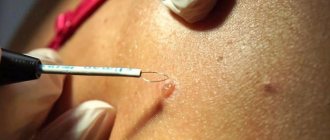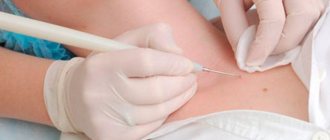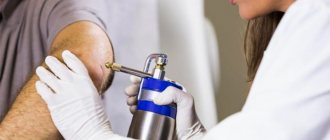Warts are benign growths on the skin caused by the human papillomavirus, which affects 80% of people. The virus appears during decreased immunity, stress, and also after infectious diseases. The only way to treat warts is to remove them using laser, cryodestruction, radio wave surgery, electrocoagulation and other techniques.
Each removal method has its own advantages and disadvantages. In our clinic, to remove warts, we use a modern radio wave device “Surgitron”, which minimally injures the tissue and promotes rapid healing of the wound surface.
Removal of moles and warts using the Surgitron radio wave apparatus
Moles or pigmented nevi are the most common neoplasms of smooth human skin. They are usually benign in nature, so they are eliminated only if there are medical or cosmetic (aesthetic) indications. The Podology Clinic successfully practices the removal of skin tumors (moles and warts) using the Surgitron radio wave apparatus.
The essence of the radiosurgical method of removal
The effect of the method is that under the influence of electric current, skin and soft tissue cells heat up, expand, the cellular fluid boils and evaporates. The result is an incision of the required depth with simultaneous disinfection and blood clotting. For this purpose, a fairly thin electrode is used, also called an electric knife, which does not heat up at all during the procedure. Removal by radio wave is a non-contact method, because the instrument itself does not produce a mechanical effect on the dermis. We can say that the use of radiosurgical method for removing tumors leaves virtually no traces.
How does Surgitron work?
Surgitron, used in the Podology Clinic, is an original portable medical device for radio wave surgery, manufactured by Ellman (USA). It is also called a radio knife, because it is a modern and highly effective alternative to the classic scalpel.
Surgitron uses highly targeted short high-frequency radio waves (3.8 - 4.0 MHz) supplied to tungsten electrodes. They lead to almost instantaneous low-temperature evaporation of intracellular and extracellular fluid and the cells themselves. This is accompanied by local dry coagulation, so that the cut surface is immediately covered with a dense crust and does not bleed. And the antiseptic (disinfecting) effect of radio waves prevents infection of the surgical wound.
The electrodes do not heat up during operation. All processes occur at a temperature of 38 - 40°C, without burns and obvious swelling of surrounding tissues. The incisions for radio wave removal of warts and other formations are very narrow and low-traumatic. Therefore, postoperative wounds heal quickly and painlessly, with the formation of a soft, inconspicuous scar.
Another advantage of the method is the obtaining of high-quality tissue samples for histological examination. This is especially important when removing moles and tumor-like formations with Surgitron.
Advantages of radiofrequency surgery and the Surgitron device
To use the wart removal service in Moscow, contact our center at any convenient time.
Minimal tissue damage:
- in terms of thermal damage to tissue, Surgitron is three times safer than laser devices and electrosurgical instruments;
- when exposed to the device, a blood clot does not form in the wound;
- during removal there is practically no risk of postoperative inflammation;
- necrosis of adjacent tissues is less than 20 µm deep.
The tissue is regenerated in a short time:
- already on the third day after removal, pronounced epithelization can be noted;
- after healing, a rough scar does not form;
- pain in the wound area is insignificant.
Radio waves have a sterilizing effect on tissue, which minimizes the development of complications after surgery.
Due to the short healing time of the wound at the site of the wart without the formation of a rough scar, an excellent cosmetic result is ensured.
What can be removed by radiosurgery?
- Moles (nevi).
- Neoplasms resulting from human papillomavirus infection. These include: warts (common, plantar), condylomas, papillomas.
- Unaesthetic keloid and hypertrophic scars.
- Hemangiomas (point or star-shaped superficial vascular formations formed by intradermal small veins).
- Tumors and hyperplasia of skin appendages: sebaceous and sweat glands, hair follicles.
- Dermatofibromas are benign skin tumors formed by connective tissue.
- Granulomas are the name given to intradermal nodules that are inflammatory in nature and formed by overgrown connective tissue and an accumulation of immune cells capable of phagocytosis.
- A cutaneous horn is a cone-shaped, horny projection of skin formed by an excessive accumulation of keratinized cells and scales.
- Seborrheic or senile keratosis. This is a local accumulation of epidermal keratinizing cells, with the formation of pigmented protruding plaques-keratomas on the skin.
Removal by radiosurgical method - indications and contraindications
Recommendations: Indications for radiosurgery:
- warts on the sole;
- papillomas;
- Nevi (moles);
- spider veins;
- keratoses;
- vulgar warts;
- Hemangiomas
- Skin basal cell carcinomas
- Ingrown nail
- removal of granulation tissue after surgery;
Attention: Contraindications:
- acute inflammatory processes;
- allergy;
- presence of viral infections;
- feverish condition;
- severe liver and kidney diseases;
- diabetes;
- period of bearing a child;
- herpes
Removal of moles with Surgitron
Removal of moles with Surgitron is an outpatient procedure. Its duration depends on the size of the nevus being removed and the type of local anesthesia used. With injection anesthesia, the operation lasts no more than 10 - 15 minutes and begins almost immediately after intradermal or subcutaneous administration of the drug, and in the case of application of a cream or patch, it can take about 1 hour.
The entire mole is cut out, including a small rim of unpigmented and healthy-looking skin. The crust that forms in its place must be treated with a solution of potassium permanganate (potassium permanganate), trying not to damage or wet it for several days. This will give it the opportunity to fully develop and prevent the formation of a rough scar. You can take a shower, but it is advisable to abstain from baths and saunas for a while. Over the next few months, it is recommended to apply sunscreen with an SPF of at least 50 to the surgical area.
Types of warts
- Common warts are dome-shaped gray-brown formations with a rough, keratinized surface. Most often (but not always) they form on the hands. Their sizes can reach 1.5 cm. The formations can merge with each other, resulting in the formation of plaques.
- Plantar warts are one of the varieties of common warts. They occur on the soles of the feet and cause discomfort when walking. Externally, plantar warts are thickenings on the skin covered with dark dots. Formations appear in places where the foot comes into contact with the shoe and sweats.
- Flat warts , also called juvenile warts, form on the extremities and face. They are small in size, no more than 5 mm. Most often they have the form of pink or brown nodules. This type of wart most often affects children and adolescents.
- Thread-like - appear on the face in the chin, mouth, and around the lips. Similar formations under the mammary glands and inside the armpits are also common. They most often do not differ in color from the skin. The main danger of filamentous warts is the possibility of injury and spread of the virus, so removal is often required.
- Condylomas acuminata are pink formations in the form of nodules. After some time, they merge and create larger growths on the stem. They occur in the groin and intergluteal cavities.
- Senile warts are a benign proliferation of keratinocyte cells. They appear everywhere except on the soles. This type of wart is the only one whose formation is not associated with HPV.
Cost of tumor removal
The price of radio wave surgery depends on the type of anesthesia, volume and type of tissue removed. The final cost of the procedure also includes a consultation with a doctor and a histological examination of the removed tissue (if there are indications for this). You can view the current price of this procedure on the price list page.
The Surgitron radioknife is an effective modern surgical instrument in the hands of a qualified doctor. With its help, you can not only rid the patient of skin lesions, but also avoid the formation of rough, visible postoperative scars. The photo gallery of our Podology Clinic clearly proves this.
The use of modern radiosurgical techniques gives a high cosmetic result, allowing the patient to quickly and painlessly relieve the majority of unattractive and uncomfortable skin tumors.
The specialists of the Podology Clinic are highly qualified and have extensive clinical experience in the successful use of Surgitron. A competent and gentle approach, the use of effective modern painkillers, careful adherence to aseptic rules - all this ensures a highly aesthetic result.
You can clarify your questions and make an appointment with a dermatologist by calling the phone number listed on the website in the “contacts” section.
Areas of use
The scope of application of the method is quite diverse. Its advantages are:
- fairly affordable price;
- minimal probability of relapse (2-3%);
- minimal blood loss (excellent coagulating effect);
- fairly quick recovery after the procedure;
- minimal trauma to the skin surface and mucous membranes;
- minimal likelihood of scarring;
- there is no contact of the device with the skin (the possibility of infection is excluded);
- it is impossible to get burned;
- There is no necrosis of tissue edges.
- no hospitalization required;
- in most cases, anesthesia is not required;
- sterility of the procedure;
- no additional treatment of the treated area with medications is required;
- there are no negative consequences in the form of swelling and pain;
- allowed for use in women who have given birth;
Surgery and rehabilitation period
The radio wave procedure usually lasts 15-20 minutes.
- The patient undergoes a preliminary examination, during which the doctor determines whether there are contraindications to the procedure and possible allergic reactions, and also during which the doctor warns about behavior during the rehabilitation period.
- The affected area is treated with an antiseptic solution (if necessary, local anesthesia)
- The doctor sets the required power and selects the desired electrode on the Surgitron device.
- The process of cauterizing the formation with a radio knife begins.
- The operating area is again treated with an antiseptic, after which, if necessary, a gauze bandage is applied.
During the rehabilitation period, treatment with special ointments and preparations that accelerate healing is recommended. Exposure to water and direct sunlight should also be avoided; thermal procedures (saunas, baths) should also be postponed until complete healing. It is strictly forbidden to remove the resulting crust, as this can serve as an obstacle to regeneration, and even cause the formation of a scar or scar. The complete recovery process takes up to two weeks.
Where papillomas can be removed and the price of this operation are the two questions that most often concern those patients who are faced with this problem. Come to our medical center and we will help you get rid of them!











